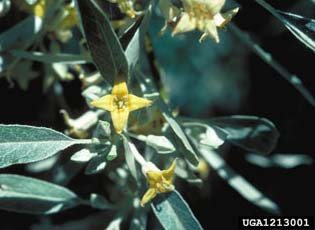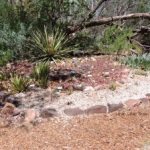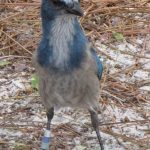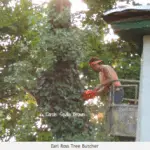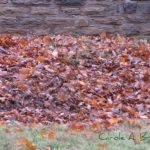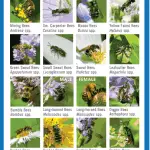Our weekly saga continues with the worst of the worst invasive plants. Plants so harmful to ecosystems they should never be planted, yet alone sold.
Topping the noxious list this week is Autumn Olive (Elaeagnus umbellata) and Russian Olive (Elaeagnus angustifolia), two plants in the same genus that are leaving a swath of destruction in their path. Just take a look at the states in which they are causing problems: Russian Olive and Autumn Olive.
(c) Dave Powell USDA www.invasive.org
Invasive Russian Olive (c) Dave Powell USDA www.invasive.org
Autumn Olive is native to China, Korea, and Japan. Russian Olive is native to southeast Asia. They were brought to the US in 1830 for cultivation and sale by the horticultural industry. They were widely planted by wildlife managers as food and shelter for wildlife.
Years ago as I was driving along the highway on my way to visit Cape May, NJ, I noticed large masses of shrubs with beautiful, silvery leaves. I pulled over and snapped a few photos so I could later identify this plant. Imagine my dismay when I discovered that this plant is invasive in almost every state in the country.
Here’s what damage it does to ecosystems:
-
It will grow in open forests, prairies, roadside edges, floodplains in sun and in part shade
It produces large amounts of small fruits, which birds seem to love. This is a problem because the birds spread the seeds far and wide in their excrement
Russian Olive/Autumn Olive fixes nitrogen in the soil, thus changing the soil chemistry and altering native plant communities
Shrubs grow so densely that native plants are crowded out
Seedlings can be pulled by hand but the shrub readily resprouts if cut.
Dense stands are very difficult to eradicate.
There are native Elaeagnus species in this country, including: Silverberry (Elaeagnus commutata), Silver Buffaloberry (Shepherdia argentea), and Russet Buffaloberry (Shepherdia canadensis). These are much better choices than either Autumn Olive or Russian Olive.
If your local nursery is selling either of these noxious, invasive plants, please educate them just how dangerous invasive plants are to our ecosystems.
More From Ecosystem Gardening:
Submit your review | |
Between the two plants, I'd choose Autumn Olive as being the worst due to several factors. Autumn Olive is harder to eradicate, evergreen, spinier and nastier overall. Olive Autumn is also sold locally whereas Russian Olive isn't. Both are enjoyable to kill but Autumn Olive is more of a challenge to get rid of. Russian Olive drupes are also palpable to humans whereas Autumn Olive aren't.

